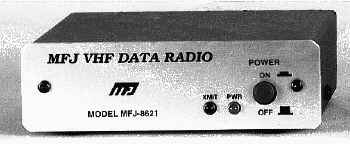 MFJ 8621 - This is an excellent entry-level radio. This
radio has been used extensively by APRS users. The 8621 is a single channel, crystal
controlled, 5w radio. One version (part # 8621/X2) comes tuned for the U.S. national APRS
frequency of 144.390. These radios have also been used for dedicated APRS digis and remote
Weather Stations. They are 12v, light weight and small in size. Best of all it is
inexpensive.
MFJ 8621 - This is an excellent entry-level radio. This
radio has been used extensively by APRS users. The 8621 is a single channel, crystal
controlled, 5w radio. One version (part # 8621/X2) comes tuned for the U.S. national APRS
frequency of 144.390. These radios have also been used for dedicated APRS digis and remote
Weather Stations. They are 12v, light weight and small in size. Best of all it is
inexpensive.
![]()
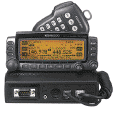 Kenwood - Kenwood, Inc.
currently manufactures two radios with a TNC and APRS software built-in! In December 1998,
Kewood introduced its TH-D7, dual band, hand-held radio. There are two
models, the D7A USA version and the D7E European. Recenlty the radio software has been
upgraded to the G version that adds functions to allow use of the radio for APRS Satellite
operations! A year later, Kenwood released the TM-D700, dual band, mobile
radio. Both of these radios have GPS and computer connection ports. They can also be used
with the VC-H1 SSTV device.
Kenwood - Kenwood, Inc.
currently manufactures two radios with a TNC and APRS software built-in! In December 1998,
Kewood introduced its TH-D7, dual band, hand-held radio. There are two
models, the D7A USA version and the D7E European. Recenlty the radio software has been
upgraded to the G version that adds functions to allow use of the radio for APRS Satellite
operations! A year later, Kenwood released the TM-D700, dual band, mobile
radio. Both of these radios have GPS and computer connection ports. They can also be used
with the VC-H1 SSTV device.
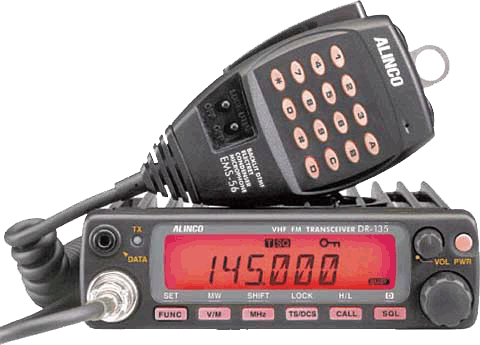 Alinco - Alinco has just released the DR-135TP. This is
a 2m mobile radio with a TNC built-in APRS support. This radio has not been approved by
the FCC. Not very much is know about this radio other than it is has the same TNC chip it
as the Kenwood. There was one of these radios in use at the APRS booth at Dayton
Hamvention 2000 and it worked with the APRS software just fine. We will bring this
information up-to-date as it becomes available.
Alinco - Alinco has just released the DR-135TP. This is
a 2m mobile radio with a TNC built-in APRS support. This radio has not been approved by
the FCC. Not very much is know about this radio other than it is has the same TNC chip it
as the Kenwood. There was one of these radios in use at the APRS booth at Dayton
Hamvention 2000 and it worked with the APRS software just fine. We will bring this
information up-to-date as it becomes available.
Radio Shack HTX-202 - This Radio Shack radio has been discontinued, but we mention it here because they can be found at ham fests and make excellent APRS radios for mobile use. This radio works well as a mobile tracker, digi, or other specialized setup. The HTX-202 has an excellent durability track record and is highly recommended for APRS use.
2m Radio - Just about any 2m radio will work for APRS. With a TNC you can turn just about any 2m radio into a useable APRS radio. Any radio that has been setup for 1200 baud packet should work just fine. However, a TNC is not always required for APRS use. There are other devices such as the Tigertronics TM-1, TAPR's Mic-e, the Pic-e and others that eliminate the need for a TNC. These devices are usuall used in mobile or other tracking applications. We have them listed here on this page.
TNC
Kantronics - The Kantronics KPC-3 and KPC-3+ are probably the most commonly used TNC's for APRS. Kantronics has supported APRS with numerous releases of the ROMs that make building a tracker or digi a wwhole lot easier. The latest ROM upgrade version 8.3. These TNC's are used for all areas of APRS. For Home stations, Trackers, and Digis. Kantronics has tailored the TNC for APRS operations. You can find these TNC's at hamfests.
MFJ - MFJ has a variety of good TNC's that are used by many for APRS. Such as the MFJ-1270C, 1276 and 1278B. These TNC also have many other features for more than just APRS Packet.
PicoPacket - The PicoPacket is offered by PacComm are excellent for new users. They are small and inexpensive TNCs.
GPS

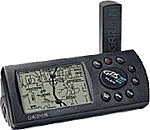
Garmin - Garmin has several GPS's available that will work with APRS. Shown here are the GPS 12MAP, GPS II Plus and Street Pilot. APRS requires NMEA 0183 data and any of these Garmin GPS's that have the data port and will work.
Magellan - The Magellan is probably the second most used GPS by APRS users. The key is to have a NMEA 0183 data output for APRS. Shown here is the model 310.
Earthmate - The Delorme Earthmate GPS comes with the Street Atlas mapping software. This GPS can be used independently with APRS or with Street Atlas and APRS+ software. This too is a very popular GPS.
Pharos - Size of an active antenna, the iGPS-180 integrates a low profile patch antenna, a 12 channel parallel GPS receiver based on SiRFstar/LX and a standard RS232 transceiver in a water resistant plastic enclosure.
Specialized Equipment
12v Touch Screen Mobile Computers - These systems are of limited quantity. Sold by Compu-Comm directly to APRS users. These system operate on 12v @ less than 2 amps. A special version of the dosAPRS software, called APRStch, has been written to take advantage of the touch screen features. Click here to see an example of the computer installed in a mobile environment.

Mic-E - The Mic-E encoder, developed by TAPR, is a kit that you can use with just about any mobile radio, converting it into a APRS traking station. The Mic-E connects between the microphone and the radio. It has a GPS and computer serial port for programming. This interface box also contains switches to change messages and other specialized data. This device eliminates the need for a TNC and offers many features for APRS mobile applications.
Mic-Lite - The Mic-Lite, developed by Bob Bruninga, is simular to the Mic-E but in a small package. This device, along with $10 in parts, can be used with almost any radio for APRS. This is the "poor-mans" version of mobile a APRS application. It also accepts GPS input.
Tigertronics TM-1 & 1+ - The TM-1 and TM-1+ are devices developed and manufactured by Tigertronics, Inc. These devices are simular to the Mic-E and Mic-Lite, however, they offer several additional functions not available anywhere else. These devices are an interface for the GPS and Radio for mobile and tracking applications. This is a well built commercial product.
HamHUD - The HamHUD is a new device that adjusts the transmit rate depending on the speed of travel of a mobile APRS station.
WX & Other Stuff
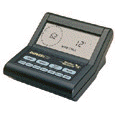
WX - One of the most useful pieces of equipment that you can connect to your APRS system is a weather station. Your weather information is then made available to the APRS network and can be helpful in the SKYWARN and other weather related nets. There are two recommend manufacturers of weather equipment. Davis and Peet Bros. Both of these are supported by the APRS software.
DF - Some DF equipment such as the Agrelo DFjr is supported by the APRS software making the Fox Hunting simpler. There is other DF equipment available that also works with APRS such as the XXX Dopler Units. Although they are handy, doppler units are not required to use APRS for DFing. See the help files for more information on how to DF with APRS.
Antennas - We've included antennas becasue performance of some radio equipment, such as the TH-D7, can be improved. For APRS satellite work, a long whip or the Arrow antenna is highly recommended.
Cables & Connectors - There are several specialized cables that you will want to build or buy.
Well, we've shown you a lot so far. Your probably not sure what to do next or how to get started. The first decision for you to make its to decide to get started in APRS. As you've seen there is a multitude of software to choose from. We suggest that you pick the version that operates on your most comfortable system. If you like DOS, then go get dosAPRS, Windows, winAPRS. You get the idea. Now take that software and play with it a bit, get used to the menus, even if your not sure what the commands mean. Get use to the menus and command locations.
When your comfortable, its time to put your station together. We recommend using a TNC and 2m Radio at your home before looking are a mobile application. If your sure that you not going to build a mobile station, then think about using a dedicated radio, maybe an old crystaled radio and a simple TNC that your not going to use on any other digital modes. Unless, of course, your interested in using the TNC for other modes a high priced multi-mode Data Controller is not needed. However, if your thinking of a mobile setup, then you may want to look at one of the TNC replacements that are much smaller and less expensive. Or if your thinking of just a mobile application then on of the new all-in-one Radio/TNC/APRS units from Kenwood or Alinco. These are expensive units, but may be less than buying the items separately.
Finally, we have shown you most of what is available for APRS. APRS is a growing part of our hobby and we will try to stay on top of new developments in APRS technology. Be sure to come back here and look at what is available. What follows in the next few pages are more detailed information on how to setup and use APRS and a links page to the hardware listed here and numerous other user pages. We hope that you have enjoyed using www.aprshelp.com and will come back here for the latest in APRS technology.